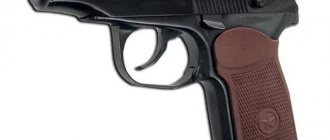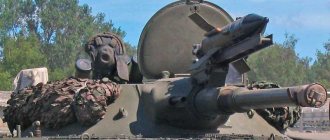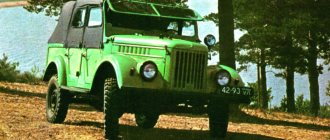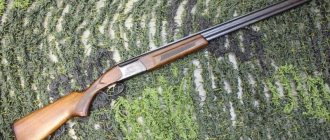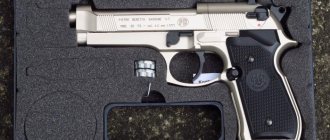A large number of excellent pistols were produced in our country, among which we can highlight legendary models, such as the Makarov pistol, and simply good examples of weapons, which, in fact, became the GSh-18 self-loading pistol. It was developed relatively recently - in the late 90s of the last century. However, due to the fact that weapons have a different calculation of time, and also taking into account the general speed of progress, he was lucky to remain in the “relevant” column to this day.
Pistol GSh-18 disassembled
History of the creation of the GSh-18 pistol
Its creators were two domestic gunsmith designers - Vasily Gryazev and Arkady Shipunov. They worked at the Tula arms factory. As a result, their brainchild now bears the first letters of their surnames, and the postscript “18” is the number of cartridges in the clip. It should be added that these 18 units are the absolute maximum in all modifications.
At the end of the 90s, when the combat effectiveness of the army dropped significantly after political and financial crises in the country, the problem arose of creating a new short-barreled pistol that could meet modern standards of tactical and technical characteristics.
Before this, for decades, the legendary Makarov pistol was the shortest-barreled pistol, but development did not last forever. Already at the end of the 80s, they came to the conclusion that the PM lags behind its Western counterparts, and its “Achilles heel” was a weak 9x18 mm cartridge, which did not have the necessary power to perform combat missions. In general, this drawback was the result of a classic mistake, when one design bureau is engaged in the development of weapons, and another design bureau is engaged in the cartridge.
Modern body armor of the second and especially the third generation put a kind of end to the Makarov: it remained powerless against them. We had to create a new cartridge that would be on par with the NATO Parabellum. First of all, it was necessary to increase the charge power, but not due to increased impulse, but due to the high muzzle energy of the bullet, inside of which there would be an armor-piercing core.
They produced a PM bullet, which had improved armor-piercing characteristics. It was possible to increase the initial speed of the projectile from 315 meters per second to 500-600. As a result of this upgrade, the cartridge penetrated a steel sheet 5 mm thick from a distance of 10 meters, which is an excellent result for a pistol. However, in the early 90s they decided to finally replace the Makarov and organized a competition in which the best gunsmiths of the country participated.
But things went sluggishly due to reasons that were understandable to everyone in the 90s, and only in 1998, when the already mentioned group of gunsmiths joined the project, did everything move forward. Tula gunsmiths decided to use their experience in creating an armor-piercing bullet for, and took the Parabellum cartridge as the basis. It was possible to reduce the mass of the bullet, but at the same time increase the speed of the projectile, thereby this option was able to penetrate even third-class body armor, as well as hit a steel sheet 8 mm thick at a distance of 15 meters.
While the cartridge was being created, work was underway on a pistol, which was heavily influenced by the Austrian Glock-17 model, which is light in weight but extremely convenient and practical. Domestic developers decided to use the most important achievements of Austrian competitors. The test sample was manufactured in 1998, and then various tests were carried out and refined until 2000.
Pistol GSh-18
Key milestones in creating a cartridge
Therefore, the Tula residents, on their own initiative, designed their own GSh-18. The pistol was offered at a state competition. But before that, they had to do a lot of work so that their weapons did not look worse than the products of their main competitors.
From the very beginning, gunsmiths took up the issue of designing the PBP (armor-piercing) cartridge. The standard cartridge from Makarov was taken as the basis, but its design itself was largely taken from the unique subsonic SP-5. A bold decision was made - to increase the characteristics of the cartridge by increasing muzzle energy and using a powerful steel core. For this, the craftsmen suggested using a polyethylene bullet shirt. On the nose of the bullet, a bare core made of thermally hardened weapon steel is visible. This design provided many advantages.
It turned out that the speed of the bullet at the moment of the shot immediately increased from 300 to 500 m/s. In addition, the new cartridge could be used in old PM and new PMM without problems. The penetrating effect of the bullet increased by an order of magnitude. Thus, a standard Makarov cartridge at ten meters made it possible to more or less confidently penetrate only 1.5 mm of steel sheet. With the new ammunition, the PM allowed us to confidently penetrate 5 mm of steel from the same ten meters! So why did the creators still come to the idea of using the NATO Parabellum in their GSh-18? The pistol was already clearly no worse than its foreign competitors!
Design features and operating principle
Design of the GSh-18 pistol
The frame of the GSh-18 is made by analogy with the Glock: made of plastic, with special polymer inserts, as a result of which the weight of the pistol was reduced, which made it more mobile. Several polygon-shaped cuts were also made in the barrel, which are made using cold forging technology. The trigger mechanism of the GSh-18 contains the principle of double action, while the design of the mechanism is completely original. It was developed personally by Vasily Gryazev, who developed a scheme in which the bolt casing compresses the mainspring, which fits the firing pin. As a result, the bolt casing begins to move under the pressure of two springs, a return type and a combat type, then the cartridge is pushed out of the magazine.
The complete design of the pistol, as well as the cartridge design
The cartridges in the clip are staggered, but when exiting the clip they line up in one row. GSh-18 is a pistol that has four levels of safety: two automatic trigger safety devices and two safety devices that are triggered when the barrel is not fully locked. This multi-stage degree is one of the safest in the world. As a result of tests, it was found that it is able to withstand several drops from a height of 1.5 meters and not fire shots.
The essence of the automatic operation is that the barrel recoils during a short stroke, after which the barrel bore is locked by its rotation. This system, despite the fact that it can significantly reduce the size of the weapon, is used quite rarely.
How does a combat version of a pistol lie in your hand?
Owner reviews
An employee of a special unit of the Ministry of Internal Affairs of the Russian Federation with extensive combat experience about the GSh-18: “This is the first domestic pistol that gives me completely opposite assessments. The backstory is this... This is not a military secret, so I will say that officially, according to the report card, every employee of a unit similar to the one in which I have the honor to reside for the last couple of dozen. So, yo, two pistols are put in. One is automatic, of course, in the absence of others - APS. The second is any available. Available - PM, PMM-12, TT. and PYa. APS is my third copy during my service. My most preferred pistol. I am sure that there are many pistols that are more accurate, lighter, more convenient, more modern - but I know it down to the last screw. And most importantly, I know what to expect from him in battle. And in battle, it hits where the barrel is pointed, rumbles like a well-tuned and oiled sewing machine, does not shut up and eats any bulk cartridges. The automatic fire mode is not the main one, but it is pleasant and necessary in specific situations (which have happened before and still exist). But wearing it in civilian clothes is a big problem, especially for a person blessed with a child. Which you need to carry in your arms and put in an electric car... And ride in a car... With wearing on the body, the option immediately disappears - the pistol is oversized. In summer you need to hide it under clothes, in winter - on the contrary - clothes prevent you from quickly grabbing a weapon. That's why I carry this “pecal” in my bag.
GSh -18. Everyone has heard about him. They heard that he is a miracle pistol and they heard that he is a turd. I shot a hundred rounds of ammunition from it, disassembled it, assembled it, cleaned it, and formed a preliminary opinion about it. Easy. Especially without ammo. A peculiar descent - tight and unpredictable. It is impossible to handle the trigger like on a trigger pistol. Strong bounce when fired. The sharp edges of the magazine jaws plus the inability to manually load more than ten rounds make loading a magazine an unpleasant experience. The charging device itself does not have any swivels to tie a cord to it or fasten a carabiner. Otherwise, it’s not at all difficult to lose him...
All these difficulties with loading a magazine suggest such a scenario for using a pistol - two magazines are fired and you can forget about the pistol. Because even if you have spare cartridges, you won’t be able to load magazines in a combat situation, due to the fact that no one will carry a charging device with them. Even if it is available, it can easily be lost. Due to the great effort required to equip the magazine with the help of a charging device, this same magazine must be rested against a solid support, that is, it will be very difficult to equip it while holding it in weight. Of course, the situation with equipping pistol magazines in battle is unlikely, but sometimes the life of a military man presents such unpleasant surprises.
We fired a hundred rounds of ammunition from it - 7n21, Wolf and Novosibirsk. The first shots are misaligned, under-fired and the cartridge case is stuck and there is a “chimney”. A fully loaded magazine is fixed “so fucking tight.” You soon get used to the tilt of the handle, which is unusual for a domestic weapon, and the pistol no longer looks over the target. A friend who went with me to the shooting range “to try out” said: “... just write it like that, the descent is fucking awesome.” On my own behalf, I’ll add that compared to the PYa, in terms of processing, the descent of the GS is not even close. But the paradox is that “at rapid fire” he makes a “better pile” than PY. Well, the workmanship... KardeN
Ammunition
The GSh-18 pistol uses several types of ammunition:
- First of all, an armor-piercing 9x19 mm cartridge called 7N31 was created for it. The cartridge contains a core made of heat-strengthened steel. The bullet, despite its light weight, has a speed of 600 meters per second;
- Due to the fact that the pistol was developed based on the Glock, it can use the 9x19mm Parabellum cartridge;
- The domestic 9×19 mm 7N21 cartridge is perhaps the most powerful option of all. It has a steel core, and even at a distance of 55 meters it can penetrate a 4 mm steel plate, despite the low initial speed of 470 meters per second;
- 9x19 mm NATO cartridges;
- Cartridge 9x19 mm PBP (increased armor penetration) with a semi-jacketed bullet.
Of course, there are few variations of ammunition, but each of them has good performance.
Three of the six cartridges in the photo are used in the GSh-18: 7N21/31, 9×19 PB
Some disadvantages
Is the GSh-18 (pistol) good for everyone? It also has its shortcomings. Firstly, the workmanship suffers. Many owners complain that the plastic on brand new pistols is worn out and frayed. What’s worse is that it’s impossible to equip the magazine in combat conditions: its lips are too sharp, it’s very narrow. To carry out this event you need an extractor.
So in a real battle, the volume of ammunition for this weapon can be measured solely by the number of loaded magazines. Are there any other problems with the GSh-18 (pistol)? The disadvantages also lie in the extremely poor quality of processing of many of the internal surfaces of the weapon. Athletes especially complain about this.
Performance characteristics
In terms of its performance characteristics, the self-loading GSh-18 still remains one of the best pistols in its class:
- weapon weight - 0.8 kg;
- gun length - 183 mm;
- barrel length - 103 mm;
- main cartridge type - 7N31;
- caliber - 9x19 mm;
- projectile speed - 600 meters per second;
- maximum sighting range - 50 meters;
- maximum ammunition size is 18 units.
Museum version of the GSh-18 with the bolt casing removed
Problems and their solutions
During the very first tests, extremely serious problems were identified: sometimes the bolt casing completely lost its energy and stopped, buried with the extractor tooth in the bottom of the cartridge. The most offensive thing was that the bolt had only one and a half millimeters to go through. But at the same time, the spring no longer had enough energy. Gryazev easily circumvented this impasse: he came up with the idea of using a extractor without a spring. Its tooth is forced into the groove of the cartridge when the barrel rotates. The firing pin, passing through a special hole when firing, engages the extractor with the cartridge case and holds it until it hits the reflector.
Advantages and disadvantages of GSh-18
In general, many weapons experts say that the GSh-18 ultimately turned out to be a controversial weapon, and is still the subject of a lot of controversy.
Advantages
- One of the most important advantages of a weapon is its excellent ergonomics due to the comfortable design of the weapon handle, as well as its low weight;
- In addition, one cannot fail to note the large 18-round magazine. Good balance of the weapon, proper location of the center of gravity, thanks to which you can return to the aiming point with lightning speed. As a result, the GSh-18 has good accuracy of fire without losing much in accuracy;
- Excellent manufacturability, which makes it inexpensive to produce, although over time, against the background of inflation, the cost of the pistol gradually increases, and in 2012 the factory cost is a little more than 23 thousand rubles;
- A significant advantage of the pistol is its penetration capabilities thanks to the 7N31 bullet.
Flaws
But there is another side to the coin, which largely stems from the advantages of the GSh-18:
- Thus, many researchers recognize the trigger mechanism as excessively heavy and also long, and even a convenient handle option is not able to compensate for the flaw. People who have used the weapon say that its shape is too straight, resulting in an unusual feeling during use that only goes away with time;
- We also often talked about power, but it has a dark side - recoil, due to which the low weight of the weapon became only a minus;
- There are also minor drawbacks, such as the case ejecting upward instead of downward, and questions about the quality of production.
And yet, despite all the controversy, we can say with confidence that the weapon remains relevant to this day, so its disadvantages do not outweigh its advantages, and one of the most important factors is the relatively low price on the market.
In this figure we can see the staggered arrangement of pistol cartridges
Main characteristics of the production cycle
The labor intensity of producing a “Russian Glock” is three times less than that of a standard police Beretta. Of course, this has a positive effect on the cost of the weapon. The main role in simplifying and reducing the cost of production is played by the frame itself, which is produced by simple casting from a durable polymer. This process takes only five minutes. The strength of the resulting frame is verified through rigorous tests. The use of a large number of polymers made it possible to achieve an unprecedentedly low weight of the weapon: only 0.47 kg without a magazine.
The bolt casing is the second most labor-intensive part of the pistol. To simplify production, the housing and bolt itself are separate parts that can be separated for cleaning. The casing itself is made from a stamped metal sheet, followed by finishing on metal-cutting machines. All this made it possible to significantly simplify and reduce the cost of the production process.
Main modifications
Now we’ll talk about the three main modifications of the GSh-18 pistol, two of which are not combat models.
Tactical model
Tactical model of the GSh-18 pistol
So, in 2012, serial production of a new tactical model began at the Tula Arms Plant. Its main difference from the classic version is the new polymer frame material, as well as elements of the famous Picatinny rail; we also had to increase the length of the frame in order to mount a silent firing device, in simple words a silencer.
Sports model
In October '10, a sports version was introduced. The shape of the trigger guard was changed and corrugation was added. Initially, the magazine included 10 rounds, but since 2012 a version with 18 rounds has gone into production.
Shooting from the sports version of the GSh-18 pistol
Traumatic model
This model was created for a specialized .45 Rubber pneumatic cartridge. The main difference between such weapons and the combat type is a significant simplification of the design: the safety lock in the area of the trigger is completely absent due to its uselessness. The essence of how automatic filling works is the energy that is created during recoil. The magazine has been reduced to 7 charges. But this project was closed when amendments were made to the legislation on traumatic weapons. And they decided to close the GS project with the addition 18T.
Traumatic version of GSh-18
As a result, we can say that the Gryazev-Shipunov duo did their job well, despite the criticism. They managed to create a good model both for individual units of the Ministry of Internal Affairs and the Ministry of Justice, and for athletes. This work immortalized two designers in the history of Russian weapons, and once again proved that the format of advanced weapons is subject to our craftsmen.
If you have any questions, constructive suggestions, or just some thoughts, feel free to express them, because this type of interaction is very important for us.


